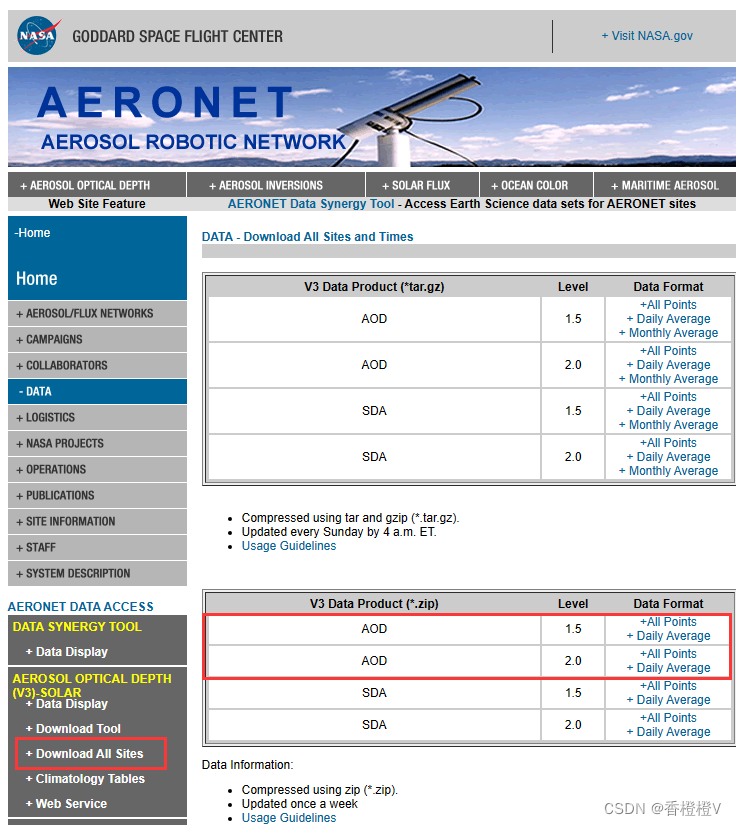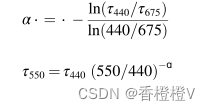AERONET 数据处理
1. AERONET 数据下载
主要针对AOD数据进行处理,以便与地面站点的验证。AERONET数据下载官网

2. 批量更改后缀
站点数据为文本存取,批量更改文件后缀名为*.txt,便于后续处理。
!#!/usr/bin/python
# -*- coding: utf-8 -*-
import pandas as pd
import numpy as np
import os
import glob
from scipy.optimize import curve_fit
import datetime as dt
import math
# 批量更改后缀名
InputPath=r'G:\AERONET\AOD_Level20_All_Points_V3\AOD\AOD20\ALL_POINTS'
File=glob.glob(os.path.join(InputPath,'*'))
for i in File:
po=i.replace('.','_')
newName = po+'.txt' #修改为目标后缀
os.rename(i, newName)
结果如下:

3. 合并所需要使用的站点数据
将所需要的站点数据进行筛选放入同一文件夹下,进行站点数据的合并
#合并所需要的站点数据
# InputPath=r'G:\AERONET\AOD_Level20_All_Points_V3\AOD\AOD20\ALL_POINTS'
File=glob.glob(os.path.join(InputPath,'*.txt'))
#df_=pd.read_csv(File[0],header=6,index_col=False,na_values=['N/A'])#index_col=False为去掉第一列作为索引值
dateparse = lambda x: dt.datetime.strptime(x, "%d:%m:%Y %H:%M:%S") #日期的转换
df=pd.DataFrame(columns=['AERONET_Site_Name','Site_Latitude(Degrees)','Site_Longitude(Degrees)','Site_Elevation(m)',
'Dates',"Day_of_Year","Precipitable_Water(cm)",'AOD_440nm',"AOD_500nm",'AOD_675nm','440-675_Angstrom_Exponent','Interpolation_AOD_550nm'])#所需要的字段
for i in File:
aeronet = pd.read_csv(i,header=6, na_values=['N/A'],index_col=False,
parse_dates={'Dates':[0,1]},
date_parser=dateparse)
aeronet=aeronet.loc[:,['AERONET_Site_Name','Site_Latitude(Degrees)','Site_Longitude(Degrees)','Site_Elevation(m)',
'Dates',"Day_of_Year","Precipitable_Water(cm)",'AOD_440nm',"AOD_500nm",'AOD_675nm','440-675_Angstrom_Exponent',]]
#去除无效值
aeronet=aeronet.loc[aeronet['AOD_440nm'].map(int)!=-999]
aeronet=aeronet.loc[aeronet['AOD_500nm'].map(int)!=-999]
aeronet=aeronet.loc[aeronet['AOD_675nm'].map(int)!=-999]
aeronet=aeronet.loc[aeronet['440-675_Angstrom_Exponent'].map(int)!=-999]
aeronet=aeronet.loc[aeronet['Precipitable_Water(cm)'].map(int)!=-999]
df=pd.concat([aeronet,df],axis =0)
# df.to_csv(r'E:\Orange\desktop\wins\aeronet\merge.csv')#保存为csv
4. AOD插值 (550nm)
为了卫星能与地面观测值能够进行比较,需要通过波段插值来获550nm通道的AOD值
4.1 Angstrom指数插值方法(Angstrom, 1929)
使用440nm,675nm 通道的AOD,结合440-675_Angstrom 指数,插值550nm AOD,公式如下:

#使用波长指数(440-675_Angstrom)拟合插值550nmAOD
df['AOD_440nm']=df['AOD_440nm'].astype(float)
df['AOD_440nm']=df['AOD_440nm'].astype(float)
df['AOD_675nm']=df['AOD_675nm'].astype(float)
df['440-675_Angstrom_Exponent']=df['440-675_Angstrom_Exponent'].astype(float)
df['Interpolation_AOD_550nm']=df['Interpolation_AOD_550nm'].astype(float)
df['Interpolation_AOD_550nm']=df.apply(lambda x: x['AOD_440nm']*math.pow((550/440), -x['440-675_Angstrom_Exponent']) , axis=1)
df.to_csv(r'E:\Orange\desktop\wins\aeronet\merge.csv',index=False)
4.2 二次多项式插值(Eck et al., 1999)
相对于Angstrom波长指数插值方法,二次多项式插值法可插值出精度更高、更可靠的550nm通道处AOD值。这主要是因为Angstrom波长指数插值方法依赖于气溶胶的荣格尺度分布(Junge,1955),而通常情况下的气溶胶粒子尺度不遵循这一分布特征(King et al.,1976),从而导致基于Angstrom波长指数插值方法结果的精度相对较差。
二次多项式插值方法公式:

#使用二次多项式拟合插值550nmAOD
# 定义要拟合的二次多项式函数
def quadratic_poly(x, a0, a1, a2):
return np.exp(a0 + a1 * np.log(x) + a2 * np.log(x)**2)
# 定义打包函数
def fit_and_compute(df):
# 提取要拟合的数据列
x_data = np.array([440, 500, 675])
y_data = np.array([df["AOD_440nm"], df["AOD_500nm"], df["AOD_675nm"]])
# 使用curve_fit进行拟合
params, _ = curve_fit(quadratic_poly, x_data, y_data)
# 计算x=550时对应的y值
x = 550
y = quadratic_poly(x, *params)
return y
df['Polyfit2_AOD_550nm'] = df.apply(fit_and_compute, axis=1)
#保存为csv
df.to_csv(r'E:\Orange\desktop\wins\aeronet\merge.csv',index=False)
希望以上内容能对大家处理AERONET 数据有所帮助!






















 534
534











 被折叠的 条评论
为什么被折叠?
被折叠的 条评论
为什么被折叠?










